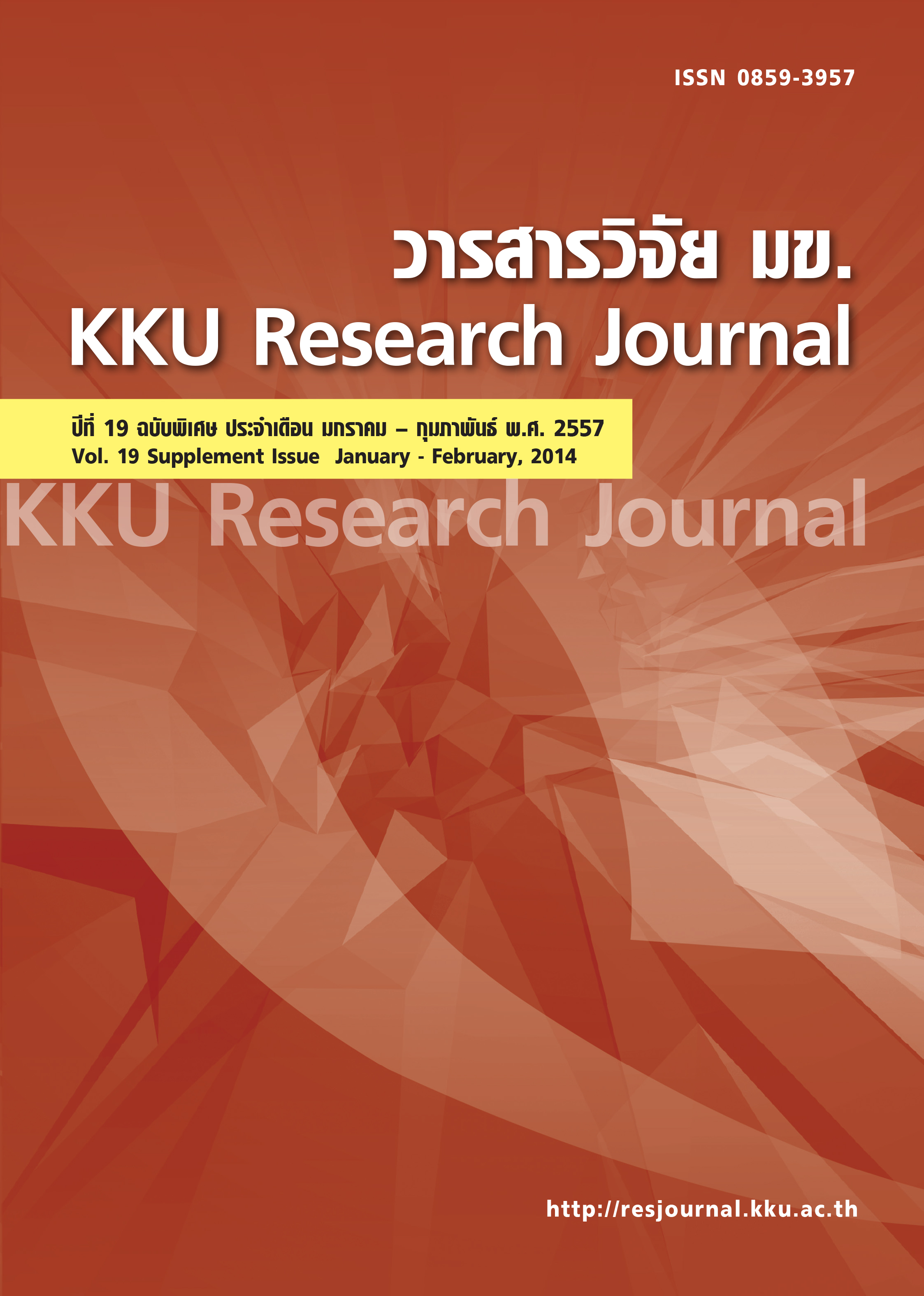Acaricidal and antibacterial activities of Xenorhabdus stockiae on different culture conditions
Main Article Content
Abstract
Xenorhabdus stockiae is an obligate symbiont bacterium of the entomopathogenic nematode, Steinernema siamkayaiSTOCK , Somsook and Reid, and it has been previously shown to have acaricidal and antibacterial activities. In this study, different media were evaluated for enhancing the acaricidal and antibacterial activities of X. stockiae. Luria Bertani broth (LB), tryptone soyptone broth (TSB) and modified yeast extract broth (YSG) were used for growing X. stockiae for 24, 48 and 72 h. The maximum acaricidal activities against Luciaphorus perniciosus Rack, mushroom mite, were found after application with cell-free supernatant ofX. stockiae grown on TSB medium for 48 h (88.50?1.00%) and 72 h (86.00?3.26%) followed by cell suspension grown on TSB for 48 h (85.00?2.00%). The surviving female mites were found to produce significantly less number of offspring, accounting for 113.50?10.15, 120.50?5.92 and 127.00?7.87 offspring/gravid female respectively, when compared to the control treatment (distilled water) that resulted in 312.75?11.02 offspring/gravid female. The culture supernatant ofX. stockiae grown using TSB medium for 48 h was shown to have maximum antibacterial activities, particularly against Staphylococcus epidermidis and Klebsiella pneumoniae. This study suggested that TSB medium was found to be the optimum medium for cultivation of X. stockiae to enhance its acaricidal and antibacterial activities.
, Somsook and Reid, and it has been previously shown to have acaricidal and antibacterial activities. In this study, different media were evaluated for enhancing the acaricidal and antibacterial activities of X. stockiae. Luria Bertani broth (LB), tryptone soyptone broth (TSB) and modified yeast extract broth (YSG) were used for growing X. stockiae for 24, 48 and 72 h. The maximum acaricidal activities against Luciaphorus perniciosus Rack, mushroom mite, were found after application with cell-free supernatant ofX. stockiae grown on TSB medium for 48 h (88.50?1.00%) and 72 h (86.00?3.26%) followed by cell suspension grown on TSB for 48 h (85.00?2.00%). The surviving female mites were found to produce significantly less number of offspring, accounting for 113.50?10.15, 120.50?5.92 and 127.00?7.87 offspring/gravid female respectively, when compared to the control treatment (distilled water) that resulted in 312.75?11.02 offspring/gravid female. The culture supernatant ofX. stockiae grown using TSB medium for 48 h was shown to have maximum antibacterial activities, particularly against Staphylococcus epidermidis and Klebsiella pneumoniae. This study suggested that TSB medium was found to be the optimum medium for cultivation of X. stockiae to enhance its acaricidal and antibacterial activities.
 , Somsook and Reid, and it has been previously shown to have acaricidal and antibacterial activities. In this study, different media were evaluated for enhancing the acaricidal and antibacterial activities of X. stockiae. Luria Bertani broth (LB), tryptone soyptone broth (TSB) and modified yeast extract broth (YSG) were used for growing X. stockiae for 24, 48 and 72 h. The maximum acaricidal activities against Luciaphorus perniciosus Rack, mushroom mite, were found after application with cell-free supernatant ofX. stockiae grown on TSB medium for 48 h (88.50?1.00%) and 72 h (86.00?3.26%) followed by cell suspension grown on TSB for 48 h (85.00?2.00%). The surviving female mites were found to produce significantly less number of offspring, accounting for 113.50?10.15, 120.50?5.92 and 127.00?7.87 offspring/gravid female respectively, when compared to the control treatment (distilled water) that resulted in 312.75?11.02 offspring/gravid female. The culture supernatant ofX. stockiae grown using TSB medium for 48 h was shown to have maximum antibacterial activities, particularly against Staphylococcus epidermidis and Klebsiella pneumoniae. This study suggested that TSB medium was found to be the optimum medium for cultivation of X. stockiae to enhance its acaricidal and antibacterial activities.
, Somsook and Reid, and it has been previously shown to have acaricidal and antibacterial activities. In this study, different media were evaluated for enhancing the acaricidal and antibacterial activities of X. stockiae. Luria Bertani broth (LB), tryptone soyptone broth (TSB) and modified yeast extract broth (YSG) were used for growing X. stockiae for 24, 48 and 72 h. The maximum acaricidal activities against Luciaphorus perniciosus Rack, mushroom mite, were found after application with cell-free supernatant ofX. stockiae grown on TSB medium for 48 h (88.50?1.00%) and 72 h (86.00?3.26%) followed by cell suspension grown on TSB for 48 h (85.00?2.00%). The surviving female mites were found to produce significantly less number of offspring, accounting for 113.50?10.15, 120.50?5.92 and 127.00?7.87 offspring/gravid female respectively, when compared to the control treatment (distilled water) that resulted in 312.75?11.02 offspring/gravid female. The culture supernatant ofX. stockiae grown using TSB medium for 48 h was shown to have maximum antibacterial activities, particularly against Staphylococcus epidermidis and Klebsiella pneumoniae. This study suggested that TSB medium was found to be the optimum medium for cultivation of X. stockiae to enhance its acaricidal and antibacterial activities.
Article Details
How to Cite
Sa-uth, C., Rattanasena, P., Bussaman, P., & Chandrapatya, A. (2017). Acaricidal and antibacterial activities of Xenorhabdus stockiae on different culture conditions. Asia-Pacific Journal of Science and Technology, 19, 148–155. retrieved from https://so01.tci-thaijo.org/index.php/APST/article/view/83113
Section
Research Articles


